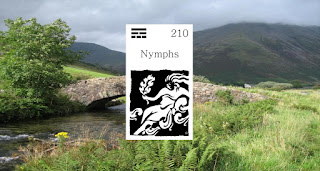Power of Place (Calling in the Spirit of Place)
The landscape, its hills, glens, plains, shorelines, nooks, and crannies, are the features of the body of the mother goddess, the earth. Place-names honour the unique qualities and lore of place. Similarly, honouring the power of place situates us in the passage of time.
Invoking the Qualities of Familiarity, Remembrance, and Continuity.
IF YOU ARE DRAWN TO THIS ORACLE, you are yearning for a place you can call your own, perhaps a home, a village, a region or country, or a community. You seem to want somewhere to root, to settle, and invest yourself fully. Not anywhere will do. The place must be uniquely right for you. The power of the place compels you. Its atmosphere, physical features, people, vegetation, smells, and wildlife attract you. It may be where you are but your psyche has not yet fully engaged it. It may be a place deeply familiar and redolent of personal memories. Wherever this place is, you are more fully alive there, as though the outer landscape mirrors the inner landscape of who you are and who you are becoming. This remarkable correspondence brings vitality and a sense of contentment and well-being.
The Celts often name a place for its qualities and lore — a dell for providing shelter, a marshy corner for its soft and rushy bottom, a ring fort to signal an otherworldly ambiance, a meadow to mark the battles fought, or a holy well for its protectress. Affecting recollection, familiar places help us to situate ourselves in the passage of time and locale. Recalling such a place, Irish poet Cathal O Searcaigh concludes: "Contradictions are cancelled on the spot."
The landscape - its rocky slopes, the forks of a river, an elder tree, a spring at its source, a widening plain, or undulating hills - reveals the features of the body of the mother earth, the goddess herself. Her countenance is found in the physical appearance of each place. The power of each place is utterly unique, so that its physiognomy and stories, so familiar, are wedded to the memory of the men and women living there. In Ireland and other Celtic lands, power implicit in the stones and earth of a place is frequently distilled in place names, recollecting in a word or phrase the deeds and fortunes of memories past. Like tonic to the human spirit, the power of place - in all its nuances, the horrific and foreboding, the beautiful and innocent - links individuals and community to lore and locale.
In discussing a genre of Irish literature known as dindseanchas, the poet Seamus Heaney writes that its poems and tales "relate the meanings of place names and constitute a form of mythological etymology ... marrying] the geographical country with the country of the mind. Heaney continues:
"The landscape was sacramental, instinct with signs, implying a system of reality beyond the visible realities. Only thirty years ago, and thirty miles from Belfast, I experienced this kind of world vestigially and as a result may have retained some vestigial sense of place as it was experienced in the older dispensation. As I walked to school, I saw Lough Beg from Mulholland's Brae, and the spire of Church Island rose out of the trees. On Church Island Sunday in September, there was a Pilgrimage out to the island, because St. Patrick was supposed to have prayed there, and prayed with such intensity that he branded the shape of his knee into a stone in the old churchyard. The rainwater that collected in that stone, of course, had healing powers, and the thorn bush beside it was pennanted with the rags used by those who rubbed their warts and sores in that water... That legend, and the ringing ascetic triumph of rising in the frosts of winter to pray ... all combined to give Blemish a nimbus of its own.
The power of place is so intimate and "self-contained" that it is virtually hidden from those who inhabit the home, the locale, the village, or the city. Entering the place, the stranger "is immediately aware of the otherness and the intimate nature of the 'place.' One senses the odours unique to the place - its sounds and artifacts.... It is this quality of intimacy, based on uniqueness, that provides the possibility for placehood." By intertwining landscape and lore, the power of place connects the human psyche within the nexus of time and space.
Over the course of life, there are times to take pilgrimages to distant places and to garner their qualities to yourself. At other times, such as now, you are invited to situate your life in a particular place, to settle in and to mature amid the familiarity and memories built up over time. Surrounded by these intimacies as though encircled by the lacework of your life, your inner life and external surroundings blend together in support of each other.















